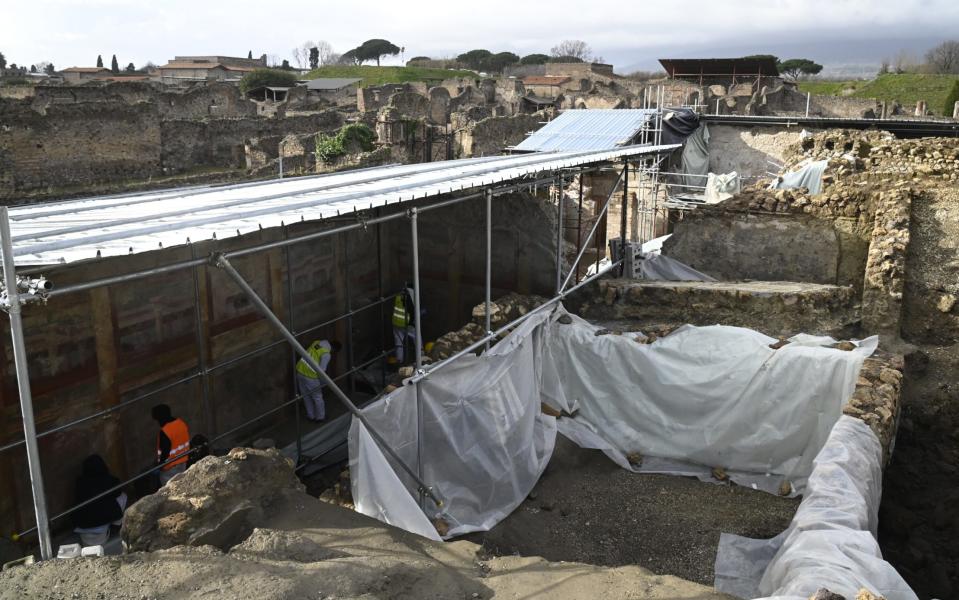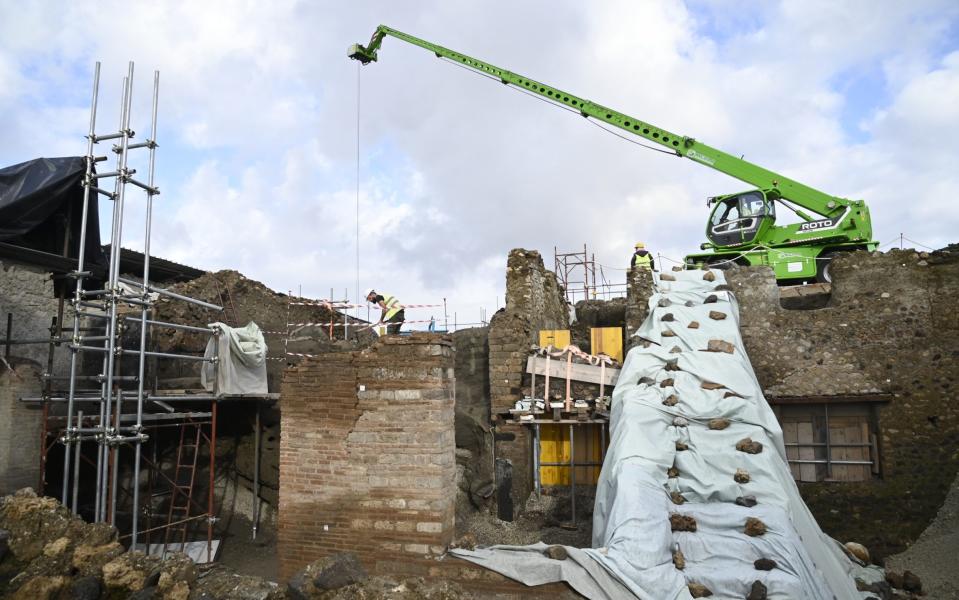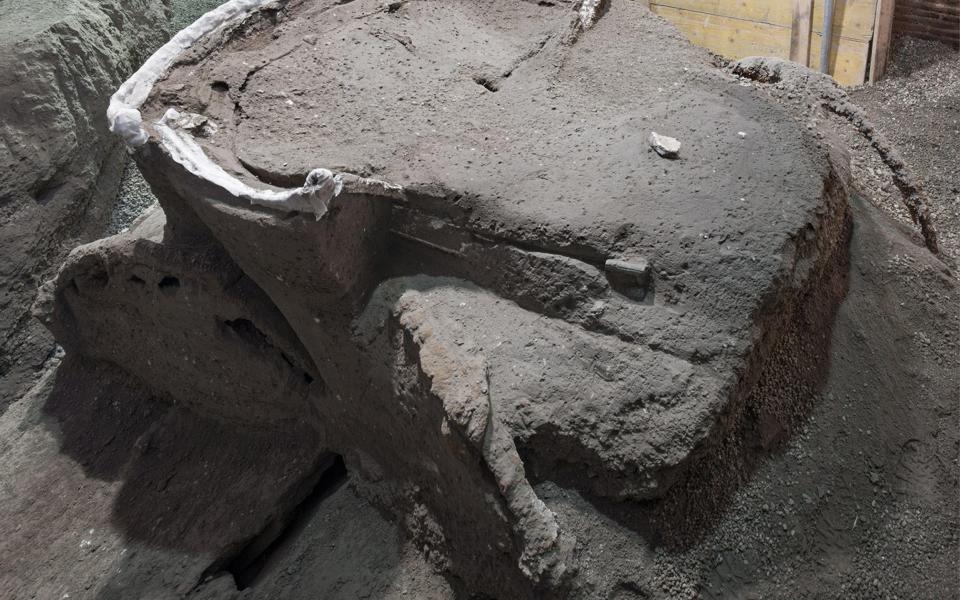Tomb raiders once dug through layers of ash and pumice, tirelessly searching for ancient treasures by candlelight.
Now, centuries later, archaeologists have discovered the tunnels used by early explorers of the Roman city of Pompeii, which was preserved under a stifling layer of volcanic debris when Mount Vesuvius erupted in AD 79, threatened by treasure hunters. .
The tunnels, which were dug through walls decorated with exquisite paintings, were excavated by workers commissioned by the Spanish Bourbon dynasty, rulers of Naples in the 18th and 19th centuries.
They were discovered in a large Roman villa that recently came to light in a recently excavated section of the city in the Bay of Naples.
From 1748 until the 19th century, tunnelers dug vertical shafts into the ground and from there excavated the remains of the ancient city, which had been submerged by volcanic ash and pumice when the volcano erupted.
They met the demands of the Bourbons, who developed a passion for finding ancient Roman treasures and displaying them in their palatial homes.
‘They were like moles’
“They were like moles,” said Alessandro Russo, one of the architects who recently discovered the tunnels. “They dug a whole labyrinth of galleries. They were very narrow and were only illuminated by the flames of the candles. There would have been a risk of the tunnels collapsing. “It would have been a dangerous job.”
One of the newly discovered tunnels ran through a palatial reception room that has recently been unearthed by Pompeii’s professional archaeologists.
He disappears, crosses the large room, which previously opened onto a colonnaded porch and an ornamental garden with fountains, and then slides into a corner.


Restorers, standing on scaffolding, carefully scrape away the dust and grime of centuries, revealing sumptuously decorated walls. On the floor, they are discovering beautifully preserved mosaics made of colored marble.
While excavating, Bourbon tunnellers used fragments of ancient terracotta tiles to shore up the walls of the tunnel and prevent it from collapsing.
“I have never seen a Bourbon tunnel like this, nor the use of ceramic materials to reinforce the walls,” said Dr. Sophie Hay, a British archaeologist who has worked on Pompeii for 20 years.
“It allows us to look at the history of the discovery of Pompeii, as well as the ancient Roman period. “The excavators were looking for the best and brightest pieces to display in their palazzi.”
Finely drawn images
Another tunnel passed through a different part of the massive villa, damaging walls decorated with finely drawn images of leopards, griffins, deer, and swans.
As workers made their way through layers of pumice and hardened ash that had settled 1,700 years earlier, they had no idea what they were destroying until it was too late.
The property is believed to have belonged to a Roman politician who evidently commanded a trading empire in Pompeii.
Next door is a bakery where slaves and mules turned huge millstones in a dimly lit chamber that would have reeked of sweat and dung. Just a few meters from the giant grinding stones, archaeologists have found a latrine where slaves relieved themselves before having to return to the backbreaking work of grinding wheat to make bread. They came from across the empire, from Britain and Gaul to Syria and Judea.


The tunnels caused enormous damage to those rooms as they blindly dug deeper and deeper underground, breaking walls and destroying sections of frescoes. At least they left the frescoes and mosaic floors intact because they were on the hunt for a more valuable treasure.
“They were looking for precious objects like statues or anything made of bronze, silver or gold,” said Raffaele Martinelli, an archaeologist working on the dig.
The Bourbon legacy was not all bad, said Gabriel Zuchtriegel, director of Pompeii.
“Without the excavations carried out by the Bourbons, Pompeii would not have come to light. It is difficult to judge them. It’s easy to say they caused damage, but at the time there were no established methods or professional archaeologists. Instead, they were largely architects or engineers commissioned by the Bourbons. “They made mistakes, but we have learned from those mistakes.”
The Bourbon tunnel diggers may have been consigned to history, but there are still underground thieves searching for ancient treasures.
‘Tombaroli’
In Italian, they are known as “tombaroli” – grave robbers. They are usually locals whose houses are located on the outskirts of Pompeii and sit high on land that still hides Roman villas that have not yet been officially excavated.
“Today’s tomb raiders use exactly the same techniques as during the Bourbon period,” Dr. Russo said. “It is a big problem in the entire Pompeii area. They dig tunnels under your houses or gardens, making them very difficult to detect. “You can’t see them.”
In 2019, authorities discovered an illegal tunnel leading from beneath a modern house on the outskirts of Pompeii to the remains of a large rural villa in an area known as Civita Giuliana.
When they explored the illegal excavation, they found an extraordinary find: an ancient Roman chariot with elaborate silver and bronze decorations and a stable with the remains of three horses. The chariot was known in Latin as a “pilentum,” a carriage used for ceremonies such as accompanying a bride to her new home.


“It is difficult to combat grave robbers because they operate over a very large area,” Dr. Russo said. “The good news is that it is more difficult for them to sell what they find; there are much stricter controls on the trafficking of artifacts.”